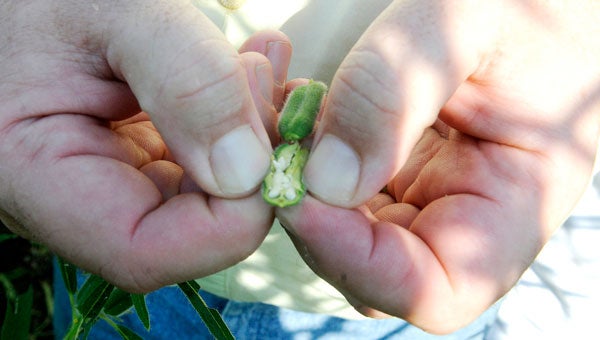Local farmer sowing a new seed
Published 5:01 pm Saturday, September 7, 2013

Farmer Jay Minter opens a pre-mature sesame seed. Minter grows 610 acres of the crop across 20 different fields in Dallas County. (Josh Bergeron | Times-Journal)
By Josh Bergeron
The Selma Times-Journal
A local farmer may have discovered the latest and greatest cash crop.
Jay Minter is growing 610 acres of sesame seeds across 20 fields in Dallas County. This is his first year growing the crop.
Minter said he mainly grows cotton and peanuts, but decided to try sesame seeds after hearing positive results from other farmers.
“Some other farmers I know and respect were growing sesame and did fairly well, so I decided to give it a shot,” he said.
He didn’t originally plan to grow 610 acres, but changed his mind after deer damaged his cotton and peanut fields. Minter said he also needed to add another crop into his rotation.
“I couldn’t just let my fields sit empty,” Minter said. “Sesame has a fairly short growing time, so it fits in well.”
Sesame seeds traditionally require less water and fertilizer than row crops, such as corn and cotton and are harvested by hand in Africa and East Asia.
But Minter isn’t planning to pick each sesame seed by hand. Instead, he is growing a breed of sesame seeds that can be harvested using a combine, similar to traditional row crops.
He expects his 610 acres to yield 488,000 to 915,000 pounds of sesame, but is unsure when harvest time may come.
“It’s been a learning process because this is all so new,” Minter said. “I really can’t tell how mature the sesame is because I haven’t grown it before.”
Minter isn’t the only one venturing into uncharted territory.
Sesaco Coroporation, a subsidiary of Japanese car company Mitsubishi, developed the row-crop variety of sesame and is pushing farmers across the southeast to include the crop in a yearly rotation, field representative Zack Coker said.
Sesaco began pushing sesame in Oklahoma and Texas, which are similar in climate to where sesame is traditionally grown. The southeast, on the other hand, offers significantly more rainfall, Coker said.
“The southeast yields have been twice what they are in Texas and Oklahoma, where we originally started,” Coker said. “The only thing that sesame doesn’t like is standing water. As long as the fields drain well, sesame will do fine.”
Minter is one of hundreds of farmers contracted with Sesaco to grow sesame. His contract requires him to buy sesame seed from Sesaco and sell his harvest back to the company.
Sesaco plans to sell its sesame to confectionary food companies, Coker said.
Sesaco isn’t finished expanding into the southeast. The company’s goal is to grow 50,000 acres of sesame in the region, which would make the crop an $18 million industry in the southeast alone, according to Coker’s estimates.
“That many acres wouldn’t make it the biggest crop, but it would put it up there,” Minter said.




